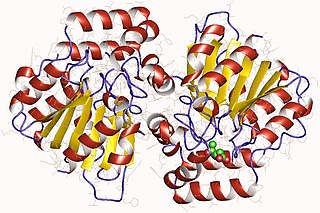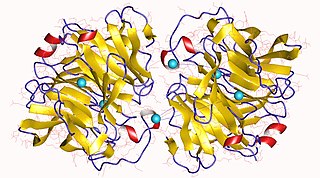In biochemistry, a metabolite is an intermediate or end product of metabolism. The term is usually used for small molecules. Metabolites have various functions, including fuel, structure, signaling, stimulatory and inhibitory effects on enzymes, catalytic activity of their own, defense, and interactions with other organisms.

Dactinomycin, also known as actinomycin D, is a chemotherapy medication used to treat a number of types of cancer. This includes Wilms tumor, rhabdomyosarcoma, Ewing's sarcoma, trophoblastic neoplasm, testicular cancer, and certain types of ovarian cancer. It is given by injection into a vein.
In enzymology, a 3-hydroxyanthranilate 4-C-methyltransferase is an enzyme that catalyzes the chemical reaction
The enzyme 1,4-lactonase (EC 3.1.1.25) catalyzes the generic reaction
The enzyme 2-pyrone-4,6-dicarboxylate lactonase (EC 3.1.1.57, LigI) catalyzes the reversible hydrolytic reaction

The enzyme 3-oxoadipate enol-lactonase (EC 3.1.1.24) catalyzes the reaction
The enzyme arylesterase (EC 3.1.1.2) catalyzes the reaction
In enzymology, a carboxymethylenebutenolidase (EC 3.1.1.45, also known as CMBL and dienelactone hydrolase) is an enzyme that catalyzes the chemical reaction
The enzyme deoxylimonate A-ring-lactonase (EC 3.1.1.46) catalyzes the reaction

The enzyme gluconolactonase (EC 3.1.1.17) catalyzes the reaction
The enzyme limonin-D-ring-lactonase (EC 3.1.1.36) catalyzes the reaction
The enzyme L-rhamnono-1,4-lactonase (EC 3.1.1.65) catalyzes the reaction
The enzyme steroid-lactonase (EC 3.1.1.37) catalyzes the reaction
The enzyme triacetate-lactonase (EC 3.1.1.38) catalyzes the reaction
The enzyme xylono-1,4-lactonase (EC 3.1.1.68) catalyzes the reaction

The alpha/beta hydrolase superfamily is a superfamily of hydrolytic enzymes of widely differing phylogenetic origin and catalytic function that share a common fold. The core of each enzyme is an alpha/beta-sheet, containing 8 beta strands connected by 6 alpha helices. The enzymes are believed to have diverged from a common ancestor, retaining little obvious sequence similarity, but preserving the arrangement of the catalytic residues. All have a catalytic triad, the elements of which are borne on loops, which are the best-conserved structural features of the fold.

Lactonase (EC 3.1.1.81, acyl-homoserine lactonase; systematic name N-acyl-L-homoserine-lactone lactonohydrolase) is a metalloenzyme, produced by certain species of bacteria, which targets and inactivates acylated homoserine lactones (AHLs). It catalyzes the reaction

Paraoxonases are a family of mammalian enzymes with aryldialkylphosphatase activity. There are three paraoxonase isozymes, which were originally discovered for their involvement in the hydrolysis of organophosphates.
The enzyme 2-oxo-3-(5-oxofuran-2-ylidene)propanoate lactonase (EC 3.1.1.91, naaC (gene); systematic name 2-oxo-3-(5-oxofuran-2-ylidene)propanoate lactonohydrolase) catalyses the reaction






